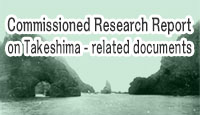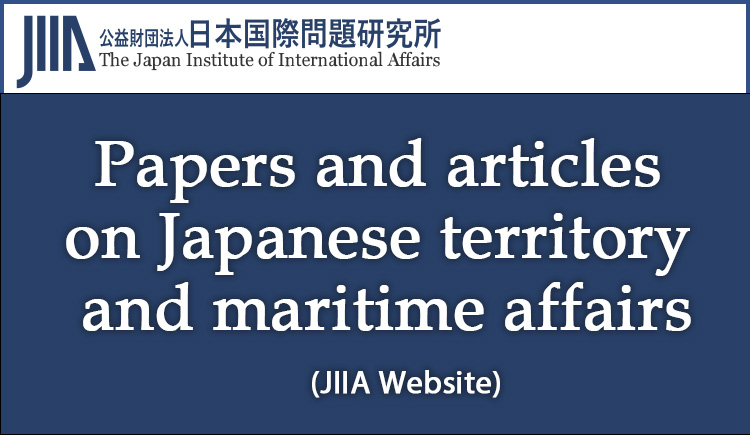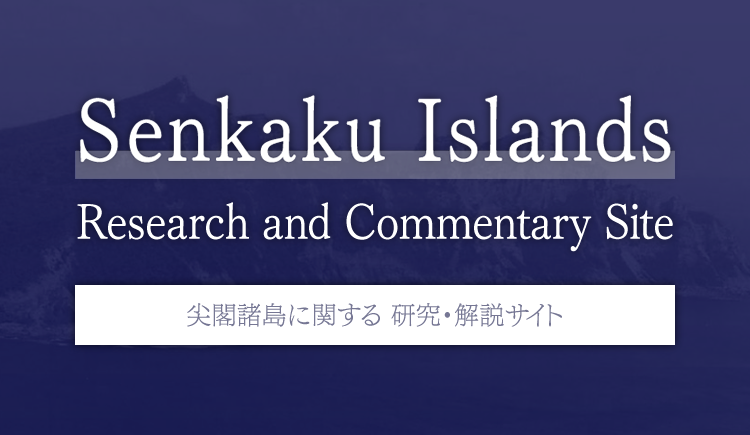The documents and materials published on this website were collected, researched, and prepared with advice from experts, as a part of a Government-commissioned project. The contents of this website do not reflect the views of the Government. Links to external sites (domains other than https://www.cas.go.jp) are not under the management of this site. For linked websites, please check with the organization/group that manages the website for the link in question.
Commentary on themes by historical period
Column
The Treaty of Peace and Takeshima
—with a focus on how the British Commonwealth countries responded—
FUJII Kenji (Advisor, Takeshima Issue Research, Shimane Prefecture)
*Adobe Acrobat Reader DC, provided by Adobe, is needed to view the PDF files. If you do not have the software, please download it from the linked site. Adobe Acrobat Reader DC
Introduction
“The Treaty of Peace with Japan” (or the San Francisco Peace Treaty, hereinafter referred to as the “Peace Treaty”) determined that Japan was to retain Takeshima, as explained in detail by Takashi Tsukamoto’s column “Comprehensive issues: The Treatment of Takeshima in the Treaty of Peace with Japan” (published on this Takeshima Research and Commentary Site on January 29, 2021).
Nevertheless, South Korea still claims otherwise, which denies the above fact. For instance, the publication titled “TEN TRUTHS ABOUT DOKDO Not Known in Japan”1 available at the Northeast Asian History Foundation website argues that: while Japan notes that “while drafting the San Francisco Peace Treaty the United States suggested that Dokdo is under the jurisdiction of Japan,” the “Rusk Note,” upon which Japan bases its claim for sovereignty over Dokdo, has no legal effect in determining the holder of sovereignty over the island, as this note only reflected the opinion of the United States, not the opinion of the Allied Powers as a whole..” This article aims to reconfirm, based on the latest findings from newly discovered documents and materials2, that South Korea’s assertion mentioned above is not true.
Note 1
(http://www.dokdohistory.com
/jpn/main.do)
Accessed on June 11, 2022.
Note 2
The author (Kenji Fujii), commissioned by the Japan Institute of International Affairs, conducted research at The National Archives United Kingdom (hereinafter, TNA), the National Archives of Australia (hereinafter, NAA), the National Archives and Records Administration (hereinafter, NARA), and the Archives New Zealand (hereinafter, ANZ). Quoted in the text with * were documents obtained as images by Streamgraph Inc., commissioned by the Office of Policy Planning and Coordination on Territory and Sovereignty, Cabinet Secretariat, from which the author benefitted.
1. History in brief of the Treaty negotiations in 1951 and the “Rusk documents”
The “Rusk documents” refer to a diplomatic note sent by the United States Government to the Government of the Republic of Korea (ROK) in August 1951, one month before the signing of the Peace Treaty. A series of bilateral working-level consultations that took place between the United States and the United Kingdom in April to May 1951 resulted in a product of the US-UK joint draft as of May 3, which provided, in Article 2 under Chapter 2 Territory, that: “Japan renounces all rights, title and claims to Korea (including Quelpart, Port Hamilton and Dagelet) ...” Subsequently, the revised US-UK joint draft produced as of June 14 of the year stated, in the provision of renunciation of Korea under Chapter 2 Territory, that “Article 2(a): Japan, recognizing the independence of Korea, renounces all right, title and claim to Korea, including the islands of Quelpart, Port Hamilton and Dagelet.”
On July 19, 1951, the ROK Government requested, in a letter to the U.S. Secretary of State, that the wording in Article 2(a) of the above joint draft be revised, by specifying Takeshima and others that should be Korean territory, as follows: “Japan, recognizing the independence of Korea, confirms that it renounced as of August 9, 1945, all right, title and claim to Korea and the islands which were part of Korea prior to its annexation by Japan, including the islands of Quelpart, Port Hamilton, Dagelet, Dokdo and Parangdo”3. In response to this request from South Korea for revision, the U.S. Government issued an official letter dated August 10, 1951 (“Rusk documents”), stating in reply that it was unable to accept South Korea’s demand for Takeshima because it understood that Japan was to retain the island4. Following such rejection, the relevant text in Article 2(a) of the revised US-UK joint draft remained the same without any further revision, and therefore, the Peace Treaty allowed Japan to retain Takeshima as part of its territory.
Note 3
Parangdo is the Korean pronunciation of what is called Harōtō in Japanese. Having heard of Socotra Rock located in the East China Sea, the Koreans mistook it for an island. In actuality, it is a submerged rock located in the East China Sea. Thus, the South Korean government claimed sovereignty over a nonexistent “island”.
Note 4
NARA, RG59, Lot54 D423, JAPANESE PEACE TREATY FILES OF JOHN FOSTER DULLES, Box 8, Korea. Included in the FY2019 Commissioned Research Report on Archives of Takeshima, Cabinet Secretariat, available HERE.
2. US-UK working-level consultations and Takeshima’s legal status
The US-UK working-level consultations in 1951 resulted in the wording in Article 2(a) of the Peace Treaty being substantially finalized. Hence, my review here will focus on the process of consultations. First, in the UK draft treaty submitted during the US-UK working-level consultations, Article 1 under Part 1 “Territorial clauses” enclosed the reach of Japan by a line within which its sovereignty would be retained, together with the description of the Sea of Japan “with the islands of Oki-Retto to the south-east and Take Shima to the north - west,” in which Takeshima was put outside the boundaries.
Meanwhile, the US draft treaty stated, in Article 2 under Chapter 2 “Sovereignty,” that “the Allied Powers recognise the full sovereignty of the Japanese people over Japan and its territorial waters,” and also contained, in Article 3 under Chapter 3 “Territory,” the description of the renunciation of Korea “Japan renounces all rights, titles and claims to Korea, Formosa and the Pescadores.” Under the leadership of John Foster Dulles, who had been appointed Advisor to the Secretary of State of the United States in April 1950, the above-mentioned simple version of the text in the draft Peace Treaty was prepared. In fact, no clause in this new draft defined Japan’s territory, and even the provision of Japan’s renunciation of Korea did not specify any name of those islands, attached to Korea, that Japan was to abandon. Still, the U.S. position that Takeshima should belong to Japan remained unchanged, as shown in the U.S. reply5 sent in October 1950 to Australia’s inquiries about the “’Seven Points’ Proposal on the Japanese Peace Treaty.”
Note 5
ANSWERS TO QUESTIONS SUBMITTED BY THE AUSTRALIAN GOVERNMENT ARISING OUT OF THE STATEMENT OF PRINCIPLES REGARDING A JAPANESE TREATY PREPARED BY THE UNITED STATES GOVERNMENT (NAA, Item ID: 140407 Japanese Peace Settlement). Included in the FY2019 Research Report. For details, see Saitō Kōhei, “Shiryōgun (1): Beikoku tainichi kōwa 7 gensoku ni taisuru Gōshū no shitsumonsho oyobi soreni taisuru Beikoku no kaitōsho” [Document Group (1) Questions Submitted by Australia to the United States Regarding the Seven Principles for a Peace Treaty with Japan, and the U.S. Response] in the “Press Release on Collecting of Archive Materials on Territory and Sovereignty (Results to date with Relation to Takeshima)” on the webpage of the Japan Institute of International Affairs on September 10, 2019 (Available HERE).
Note 6
Discussion with a party of Dutch officials of the draft J.P.T at the FO on 29th May (TNA, FO 371/92553, FJ 1022/478), page 21. See also: Summary record of meetings held at the foreign office on 29th May with the representatives of the Netherlands Government (Japanese Peace Treaty (TNA, CO537/7104)), page 134. Included in the FY2021 Publication.
3. U.K. policy on territorial clauses in the Peace Treaty
Next, another record of discussions also endorses the view that Article 3 of the US draft as revised during the US-UK working-level consultations allowed those islands to be returned to Korea to be specified in the US-UK joint draft; in fact, this document reads as follows: “British mentioned desirability of Disposing of islands between Japan and Korea by specific mention. (This might be done by inserting) ‘(including Quelpart)’ after ‘Korea’ in U.S. Article 3 [of the United States draft (added by the author)].)” 7
The above statement “desirability of disposing of islands between Japan and Korea by specific mention” had been Britain’s consistent argument throughout the drafting process of a peace treaty with Japan. In August to September 1947, a Commonwealth conference was convened in Canberra with the aim of exchanging views on drafting a peace treaty with Japan. The U.K. delegates prepared the document “Territorial, Political and General Clauses of the Treaty of Peace with Japan” as of August 27, 19478, which pointed out that: “(a) a large number of islands in waters immediately adjacent to Japan which should clearly remain under Japanese sovereignty; (b) a number of islands between Hokkaido and Sakhalin, between Hokkaido and the Kuriles, and between Japan proper and Korea in regard to the disposal of which some dispute may be expected”; and therefore, this document stressed, “very careful drafting of this section will be necessary in order to ensure that no islands are left in disputed sovereignty.”
On November 20, 1950, the United Kingdom Liaison Mission in Japan (de facto U.K. Embassy to the occupied Japan) sent a document titled “Certain matters affecting the present and future disposition of Japan’s former island territories” to the U.K. Foreign Office in London. This document was prepared in response to the Dulles-led drafting of the Peace Treaty, and as such, influenced the drafting process on the British side. It should be noted that the above-mentioned statement of “very careful drafting of this section will be necessary in order to ensure that no islands are left in disputed sovereignty” was again referred to therein, under the section “His Majesty’s Government’s policy” 9.
A certain document dated April 23, 1951, prepared by the U.K. Foreign Office on the eve of the US-UK working-level consultations, shows evidence of the Office’s deliberation of the US draft treaty. Regarding its Article 2, which provided that “the Allied Powers recognise the full sovereignty of the Japanese people over Japan and its territorial waters,” the document stated that “very careful drafting of this Section is essential in order to ensure that no islands near Japan are left in disputed sovereignty,” and pointed out that “this Article in its present form is too imprecise to meet the criterion set out above.” The U.K. Foreign Office was concerned that any such dispute over sovereignty of islands near Japan “might benefit the Soviet Union or other Communist States in Asia” 10. This document tells that Britain had a stronger sense of urgency than in the above-mentioned document prepared by the U.K. Liaison Mission in Japan, by choosing the adjective “essential” instead of “necessary” in the original document.
In the same document dated April 23, 1951, the U.K. Foreign Office subsequently criticized that Article 2 and Article 3 of the US draft treaty, when combined, could cause a sovereignty dispute over Quelpart and Takeshima since the draft failed to clarify who should own territorial rights to these islands. In this regard, the Office particularly noted that: Japanese people themselves had perceived Quelpart and Ulleungdo islands to be part of Korea; on the other hand, when it comes to Takeshima, “if it is desirable to prevent future Korean acquisition of the Hornet Islands which are uninhabited, they might be retained by Japan.” The statement reveals that although the U.K. had put Takeshima outside of Japan’s territorial line in its “UK draft as of April 1951,” Britain’s choice of such demarcation with Takeshima put outside was arbitrary and UK was ready to compromise.
As can be seen from the above, the U.K. Government was more concerned with clarifying national boundaries so as to avoid sovereignty disputes over “those islands situated between Japan and Korea,” rather than with the attribution of individual islands. Once the issue of its concern was resolved during the US-UK working-level consultations, the U.K. Government withdrew the two features in Article 1 of its draft: enclosing the reach of Japan with a territorial line, and thereby putting Takeshima outside the boundaries. Consequently, the U.S. Government’s position that Takeshima should be retained by Japan was shared with Britain, thus amounting to the “Allied Powers’ stance.”
Note 7
Check List of Positions Stated by US and UK. At April 25-27 meetings (NARA: RG59, Central Decimal File 1950-54, BOX 3008, 694.001/4-2751).* Included in the FY2021 Publication.
Note 8
Territorial, Political and General Clauses of the Treaty of Peace with Japan (NAA, Item ID: 140452 Pacific affairs - Canberra Conference Agenda - [British Commonwealth Conference on Japanese Peace Settlement, Canberra, 1947]). Included in the FY2020 Publication.
Note 9
Certain matters affecting the present and future disposition of Japan's former island territories (TNA, FO371/83825 J10114/5), page 86.
Note 10
Attaches new edition of draft brief on U.S. provisional draft peace treaty with Japan on which discussion will be held in Washington (TNA, FO371/92543, FJ1022/302), page 63. The same document (NAA) also included in the FY2019 Commissioned Research Report on Archives of Takeshima, Cabinet Secretariat, available HERE.
Takeshima
Research and Commentary Site
- I Comprehensive issues
- II Commentary on themes by historical period
- III Analysis of claims by other countries





